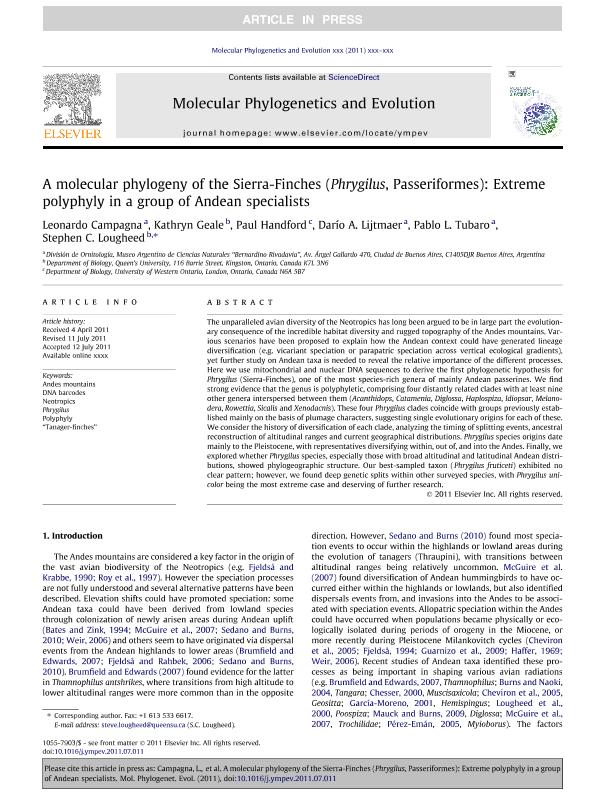Mostrar el registro sencillo del ítem
dc.contributor.author
Campagna, Leonardo

dc.contributor.author
Geale, Kathryn
dc.contributor.author
Handford, Paul
dc.contributor.author
Lijtmaer, Dario Alejandro

dc.contributor.author
Tubaro, Pablo Luis

dc.contributor.author
Lougheed, Stephen C.
dc.date.available
2019-01-29T19:53:32Z
dc.date.issued
2011-11
dc.identifier.citation
Campagna, Leonardo; Geale, Kathryn; Handford, Paul; Lijtmaer, Dario Alejandro; Tubaro, Pablo Luis; et al.; A molecular phylogeny of the Sierra-Finches (Phrygilus, Passeriformes): Extreme polyphyly in a group of Andean specialists; Academic Press Inc Elsevier Science; Molecular Phylogenetics and Evolution; 61; 2; 11-2011; 521-533
dc.identifier.issn
1055-7903
dc.identifier.uri
http://hdl.handle.net/11336/68885
dc.description.abstract
The unparalleled avian diversity of the Neotropics has long been argued to be in large part the evolutionary consequence of the incredible habitat diversity and rugged topography of the Andes mountains. Various scenarios have been proposed to explain how the Andean context could have generated lineage diversification (e.g. vicariant speciation or parapatric speciation across vertical ecological gradients), yet further study on Andean taxa is needed to reveal the relative importance of the different processes. Here we use mitochondrial and nuclear DNA sequences to derive the first phylogenetic hypothesis for Phrygilus (Sierra-Finches), one of the most species-rich genera of mainly Andean passerines. We find strong evidence that the genus is polyphyletic, comprising four distantly related clades with at least nine other genera interspersed between them (Acanthidops, Catamenia, Diglossa, Haplospiza, Idiopsar, Melanodera, Rowettia, Sicalis and Xenodacnis). These four Phrygilus clades coincide with groups previously established mainly on the basis of plumage characters, suggesting single evolutionary origins for each of these. We consider the history of diversification of each clade, analyzing the timing of splitting events, ancestral reconstruction of altitudinal ranges and current geographical distributions. Phrygilus species origins date mainly to the Pleistocene, with representatives diversifying within, out of, and into the Andes. Finally, we explored whether Phrygilus species, especially those with broad altitudinal and latitudinal Andean distributions, showed phylogeographic structure. Our best-sampled taxon (Phrygilus fruticeti) exhibited no clear pattern; however, we found deep genetic splits within other surveyed species, with Phrygilus unicolor being the most extreme case and deserving of further research.
dc.format
application/pdf
dc.language.iso
eng
dc.publisher
Academic Press Inc Elsevier Science

dc.rights
info:eu-repo/semantics/openAccess
dc.rights.uri
https://creativecommons.org/licenses/by-nc-nd/2.5/ar/
dc.subject
&Quot; Tanager-Finches&Quot;
dc.subject
Andes Mountains
dc.subject
Dna Barcodes
dc.subject
Neotropics
dc.subject
Phrygilus
dc.subject
Polyphyly
dc.subject.classification
Otras Ciencias Biológicas

dc.subject.classification
Ciencias Biológicas

dc.subject.classification
CIENCIAS NATURALES Y EXACTAS

dc.title
A molecular phylogeny of the Sierra-Finches (Phrygilus, Passeriformes): Extreme polyphyly in a group of Andean specialists
dc.type
info:eu-repo/semantics/article
dc.type
info:ar-repo/semantics/artículo
dc.type
info:eu-repo/semantics/publishedVersion
dc.date.updated
2019-01-29T18:07:21Z
dc.journal.volume
61
dc.journal.number
2
dc.journal.pagination
521-533
dc.journal.pais
Estados Unidos

dc.description.fil
Fil: Campagna, Leonardo. Consejo Nacional de Investigaciones Científicas y Técnicas. Oficina de Coordinación Administrativa Parque Centenario. Museo Argentino de Ciencias Naturales “Bernardino Rivadavia”; Argentina
dc.description.fil
Fil: Geale, Kathryn. Queens University; Canadá
dc.description.fil
Fil: Handford, Paul. University Of Guelph. Biodiversity Institute Of Ontario; Canadá
dc.description.fil
Fil: Lijtmaer, Dario Alejandro. Consejo Nacional de Investigaciones Científicas y Técnicas. Oficina de Coordinación Administrativa Parque Centenario. Museo Argentino de Ciencias Naturales “Bernardino Rivadavia”; Argentina
dc.description.fil
Fil: Tubaro, Pablo Luis. Consejo Nacional de Investigaciones Científicas y Técnicas. Oficina de Coordinación Administrativa Parque Centenario. Museo Argentino de Ciencias Naturales “Bernardino Rivadavia”; Argentina
dc.description.fil
Fil: Lougheed, Stephen C.. Queens University; Canadá
dc.journal.title
Molecular Phylogenetics and Evolution

dc.relation.alternativeid
info:eu-repo/semantics/altIdentifier/doi/http://dx.doi.org/10.1016/j.ympev.2011.07.011
dc.relation.alternativeid
info:eu-repo/semantics/altIdentifier/url/https://www.sciencedirect.com/science/article/pii/S1055790311003344
Archivos asociados
